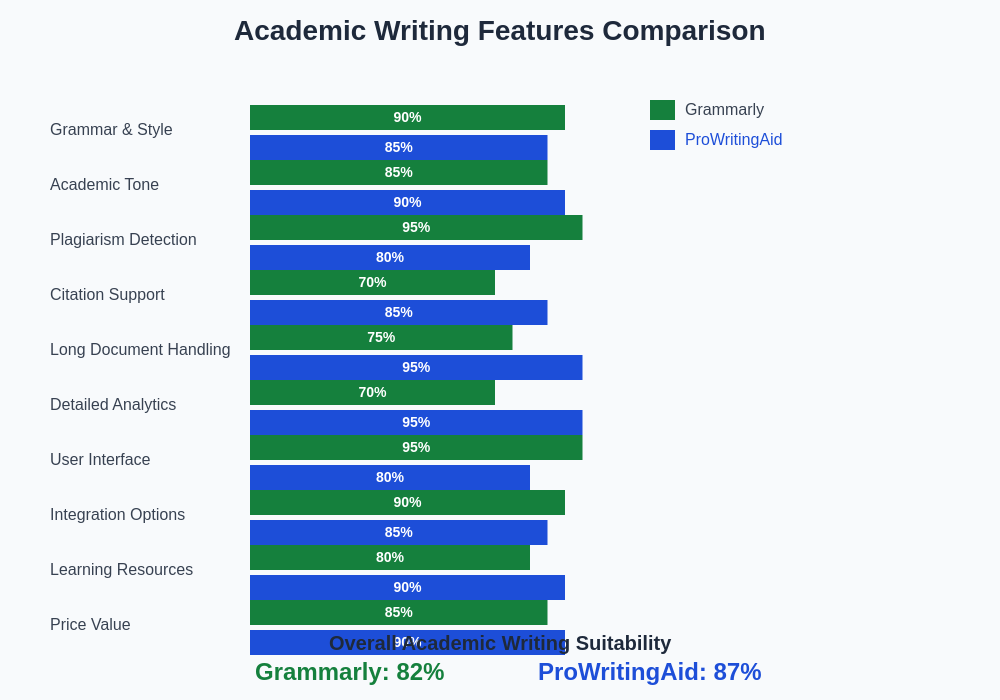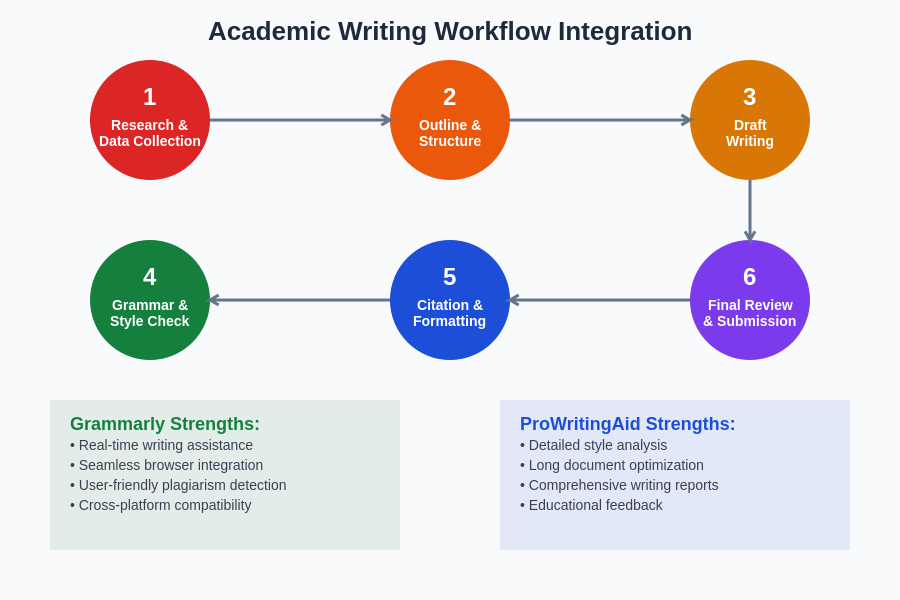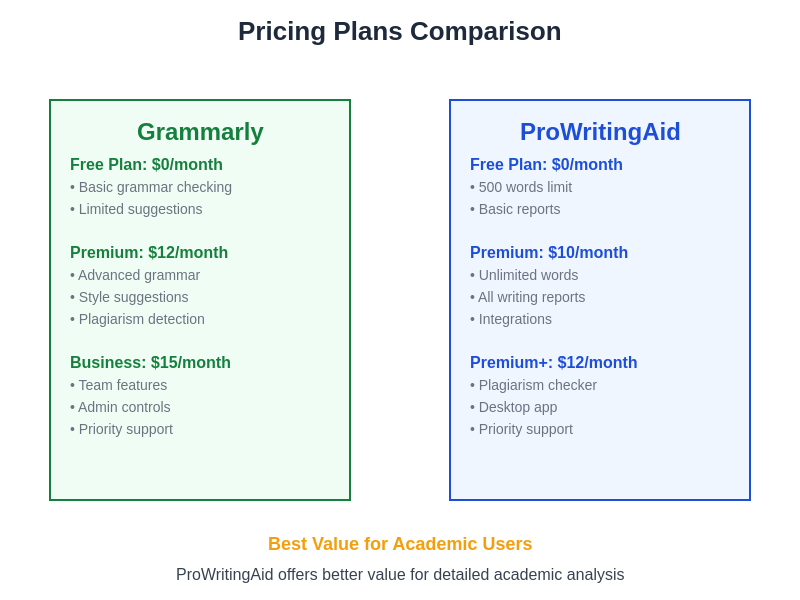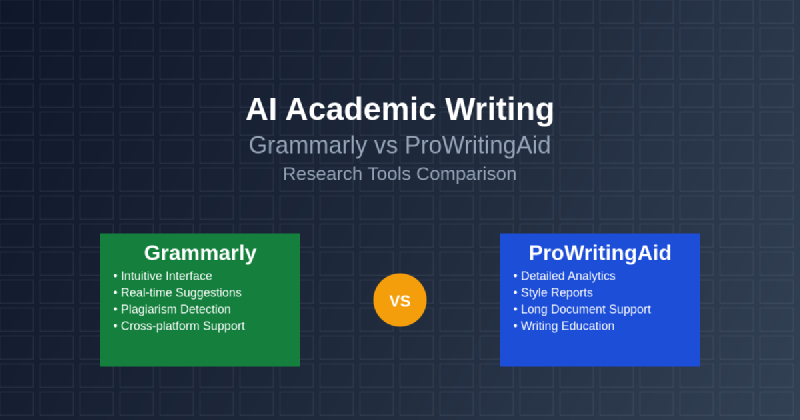The landscape of academic writing has been revolutionized by artificial intelligence-powered writing assistants that promise to enhance clarity, correctness, and scholarly rigor. Among the most prominent contenders in this space are Grammarly and ProWritingAid, two comprehensive platforms that have evolved far beyond simple grammar checkers to become sophisticated research companions for scholars, students, and academic professionals. Understanding the nuanced differences between these tools becomes crucial for researchers who demand precision, accuracy, and adherence to complex academic standards while navigating the intricate requirements of scholarly communication.
Explore the latest AI writing trends to discover cutting-edge developments in academic writing technology that are reshaping how researchers approach scholarly communication. The evolution of AI-powered writing assistance has created unprecedented opportunities for enhancing academic productivity while maintaining the rigorous standards that define quality research and scholarly discourse.
The Evolution of Academic Writing Assistance
Academic writing represents one of the most demanding forms of written communication, requiring adherence to strict formatting guidelines, precise citation protocols, and complex argumentative structures that must withstand peer review scrutiny. Traditional approaches to academic writing relied heavily on manual proofreading, extensive revision cycles, and consultation with colleagues or writing centers, processes that were often time-consuming and sometimes inconsistent in their effectiveness. The emergence of AI-powered writing assistants has fundamentally transformed this landscape by providing instant, comprehensive feedback that addresses not only basic grammatical errors but also sophisticated issues related to style, tone, clarity, and academic conventions.
Both Grammarly and ProWritingAid have positioned themselves as comprehensive solutions for academic writers, but their approaches, strengths, and target audiences differ significantly. While Grammarly has gained widespread recognition for its user-friendly interface and broad accessibility, ProWritingAid has cultivated a reputation for providing more detailed, technical analysis that appeals particularly to serious writers and academic professionals who require granular control over their writing improvement process.
Grammarly’s Academic Writing Approach
Grammarly’s evolution from a simple grammar checker to a comprehensive writing assistant has been marked by its commitment to accessibility and user experience, making advanced writing analysis available to users regardless of their technical expertise or writing background. The platform’s academic writing features have been developed with particular attention to the needs of students and researchers who require reliable, instant feedback on their scholarly work without the steep learning curve often associated with professional writing tools.
Enhance your writing with advanced AI like Claude to experience next-generation language understanding that complements traditional writing assistants with deeper contextual analysis and reasoning capabilities. The integration of multiple AI tools creates a robust ecosystem for academic writing that addresses both surface-level corrections and deeper structural improvements.
The platform’s strength lies in its sophisticated grammar and style detection algorithms that can identify subtle errors often missed by other tools, including complex issues related to subject-verb agreement, pronoun clarity, and sentence structure optimization. Grammarly’s academic writing support extends beyond basic error correction to include advanced features such as plagiarism detection, citation assistance, and tone analysis that help researchers maintain appropriate scholarly voice throughout their work.
Grammarly’s integration capabilities represent another significant advantage for academic users, with seamless compatibility across multiple platforms including Microsoft Word, Google Docs, and various web browsers. This cross-platform functionality ensures that researchers can access consistent writing assistance regardless of their preferred writing environment, maintaining continuity in their writing improvement process across different stages of research and composition.
ProWritingAid’s Research-Focused Features
ProWritingAid distinguishes itself in the academic writing space through its comprehensive analytical approach that provides writers with detailed insights into their writing patterns, strengths, and areas for improvement. The platform’s academic orientation is evident in its extensive reporting capabilities that go beyond simple error identification to offer deep analysis of writing style, readability, and structural coherence that aligns with scholarly writing expectations.
The tool’s academic writing reports include specialized analyses for factors such as sentence length variation, passive voice usage, adverb frequency, and repetitive phrasing, all of which are crucial considerations for maintaining engaging and professional academic prose. ProWritingAid’s approach to academic writing improvement emphasizes education and understanding, providing detailed explanations for suggested changes that help writers develop better instincts and improve their writing skills over time rather than simply correcting immediate errors.
ProWritingAid’s integration with reference management systems and its compatibility with academic writing software such as Scrivener make it particularly attractive to serious researchers who require sophisticated tools that can accommodate complex research workflows. The platform’s ability to analyze longer documents without performance degradation makes it especially suitable for dissertation writing, book-length manuscripts, and comprehensive research reports that exceed the typical scope of shorter academic papers.
Comparative Analysis of Core Features
The fundamental differences between Grammarly and ProWritingAid become apparent when examining their core feature sets and the depth of analysis they provide for academic writing tasks. Grammarly excels in providing intuitive, accessible writing assistance that delivers immediate value to users regardless of their writing experience, with particular strength in areas such as clarity enhancement, conciseness improvement, and readability optimization that are essential for effective academic communication.
ProWritingAid’s strength lies in its comprehensive analytical capabilities that provide writers with detailed insights into their writing patterns and habits, offering a more educational approach to writing improvement that helps users develop better writing instincts over time. The platform’s extensive reporting features include analyses of writing style consistency, pacing variation, and structural elements that are particularly valuable for long-form academic writing projects.
Both platforms offer plagiarism detection capabilities, but their implementations differ significantly in scope and integration. Grammarly’s plagiarism checker is seamlessly integrated into its primary interface and provides instant feedback during the writing process, while ProWritingAid’s plagiarism detection offers more detailed reporting and analysis that may be better suited for comprehensive manuscript review and verification processes.

The comprehensive feature analysis reveals distinct strengths for each platform, with Grammarly excelling in user experience and integration capabilities while ProWritingAid demonstrates superior performance in detailed analytics and long-form document handling that are crucial for serious academic writing projects.
Academic Citation and Reference Support
Citation accuracy and consistency represent critical requirements for academic writing, and both Grammarly and ProWritingAid have developed features to address these needs, though with different approaches and levels of sophistication. Grammarly’s citation assistance focuses on formatting consistency and basic citation structure verification, providing suggestions for common citation styles and identifying potential inconsistencies in reference formatting that could undermine the credibility of scholarly work.
ProWritingAid’s approach to citation support emphasizes integration with existing research workflows and compatibility with established reference management systems. The platform’s citation analysis tools can identify inconsistencies in citation formatting, missing references, and potential issues with citation completeness that are crucial for maintaining scholarly integrity and meeting publication standards.
Discover comprehensive research capabilities with Perplexity for advanced information gathering and fact-checking that complements citation management and ensures accuracy in scholarly references. The combination of AI-powered research tools with traditional citation management creates a comprehensive system for maintaining scholarly rigor throughout the research and writing process.
The integration capabilities of both platforms with popular citation management tools such as Zotero, Mendeley, and EndNote vary significantly, with ProWritingAid generally offering more robust compatibility with research-focused software ecosystems. This integration support becomes particularly important for researchers working on complex projects that require coordination between multiple tools and platforms throughout the research and writing process.
User Interface and Accessibility Considerations
The user experience design of academic writing tools significantly impacts their adoption and effectiveness, particularly for researchers who may be working under tight deadlines or managing multiple complex projects simultaneously. Grammarly’s interface design prioritizes simplicity and accessibility, with intuitive navigation and clear visual indicators that make it easy for users to understand and implement suggested improvements without extensive training or technical expertise.
ProWritingAid’s interface reflects its more analytical approach, providing detailed dashboards and comprehensive reporting features that offer deeper insights into writing patterns and improvement opportunities. While this approach may require a steeper learning curve for new users, it provides more sophisticated analysis capabilities that can be particularly valuable for experienced academic writers who want detailed feedback on their writing development and improvement progress.
The mobile accessibility of both platforms varies significantly, with Grammarly offering more comprehensive mobile support that allows researchers to review and edit their work across different devices and contexts. ProWritingAid’s mobile capabilities are more limited, reflecting its focus on comprehensive desktop-based analysis that may be better suited for detailed manuscript review and extensive editing sessions.
Performance Analysis for Long-Form Academic Writing
Academic writing often involves lengthy documents such as dissertations, research papers, and comprehensive reports that can challenge the performance capabilities of writing assistance tools. Grammarly’s performance with long documents has improved significantly over time, though users may still experience some limitations when working with extremely lengthy manuscripts or complex formatting requirements that are common in academic writing.
ProWritingAid has been specifically designed to handle long-form writing projects effectively, with optimization for documents that may exceed typical word processing limits. The platform’s ability to maintain performance and provide consistent analysis across lengthy documents makes it particularly suitable for dissertation writing, book projects, and comprehensive research reports that require sustained attention to writing quality throughout extended writing sessions.
The cloud-based processing capabilities of both platforms affect their performance and reliability for academic users who may be working with sensitive research data or in environments with limited internet connectivity. Understanding these performance characteristics becomes crucial for researchers who need reliable access to writing assistance tools throughout their research and writing processes.
Integration with Academic Workflows
Modern academic writing rarely occurs in isolation but rather as part of complex research workflows that involve multiple tools, platforms, and collaboration requirements. Grammarly’s integration capabilities focus on broad compatibility with popular writing platforms and seamless operation across different environments, making it easy to incorporate into existing writing routines without significant workflow disruption.

ProWritingAid’s integration approach emphasizes compatibility with specialized academic writing software and research management tools, providing more sophisticated connectivity options for users who have invested in comprehensive research technology ecosystems. The platform’s compatibility with tools such as Scrivener, Ulysses, and various academic writing applications makes it particularly attractive to serious researchers who require seamless integration across their entire research and writing toolkit.
Collaboration features represent another important consideration for academic writers who often work in teams or require feedback from colleagues, supervisors, or co-authors. Both platforms offer different approaches to collaborative writing support, with varying capabilities for sharing documents, tracking changes, and managing feedback from multiple contributors throughout the writing and revision process.
Cost Considerations and Value Proposition
The financial investment required for academic writing tools must be evaluated against the potential benefits and productivity improvements they provide, particularly for students and early-career researchers who may have limited budgets for professional tools. Grammarly’s pricing structure offers multiple tiers that can accommodate different needs and budgets, with free options that provide basic functionality and premium features that unlock advanced capabilities essential for serious academic writing.
ProWritingAid’s pricing model reflects its position as a more specialized tool, with costs that may be higher than basic writing assistants but potentially more cost-effective than comprehensive professional editing services. The platform’s lifetime licensing options can provide significant value for long-term users who anticipate ongoing academic writing needs throughout their careers.
The return on investment for academic writing tools should be evaluated not only in terms of immediate time savings and error reduction but also in terms of long-term skill development and writing improvement that can enhance career prospects and research impact. Both platforms offer different value propositions in this regard, with Grammarly focusing on immediate accessibility and productivity enhancement while ProWritingAid emphasizes comprehensive skill development and writing education.

The pricing structures of both platforms reflect their different positioning in the market, with ProWritingAid generally offering more comprehensive features at competitive price points that may provide better value for serious academic writers who require extensive analytical capabilities and long-form document support.
Advanced Features for Research Writing
Specialized features for academic and research writing distinguish professional writing assistants from basic grammar checkers, and both Grammarly and ProWritingAid have developed capabilities specifically designed to address the unique requirements of scholarly communication. Grammarly’s advanced features include sophisticated tone analysis that helps researchers maintain appropriate academic voice, plagiarism detection that ensures originality, and style consistency tools that help maintain professional standards throughout lengthy documents.
ProWritingAid’s advanced academic features include detailed readability analysis that can help researchers optimize their writing for target audiences, comprehensive style reporting that identifies patterns and inconsistencies that may not be immediately apparent, and specialized reports for factors such as sentence structure variety and vocabulary sophistication that are important for high-quality academic writing.
Both platforms have developed capabilities for handling specialized academic writing requirements such as technical terminology, complex sentence structures, and discipline-specific conventions that vary across different fields of study. Understanding how each platform handles these specialized requirements becomes crucial for researchers working in fields with specific writing conventions and expectations.
Future Developments and Technology Trends
The rapid evolution of artificial intelligence and natural language processing technologies continues to drive innovation in academic writing assistance, with both Grammarly and ProWritingAid investing in advanced capabilities that promise to further enhance their value for research and scholarly writing. Emerging technologies such as advanced semantic analysis, context-aware suggestions, and discipline-specific writing optimization represent areas where both platforms are likely to expand their capabilities.
The integration of machine learning and AI technologies into academic writing assistance tools promises to enable more sophisticated analysis of writing quality, style consistency, and effectiveness that could revolutionize how researchers approach the writing and revision process. These technological advances may also enable more personalized writing assistance that adapts to individual writing styles and preferences while maintaining adherence to academic standards and conventions.
The growing emphasis on open science and collaborative research is likely to drive demand for writing assistance tools that can support more sophisticated collaboration features, version control capabilities, and integration with emerging research platforms and technologies. Both Grammarly and ProWritingAid are positioning themselves to address these evolving needs while maintaining their core strengths in writing analysis and improvement.
The continued development of AI-powered writing assistance represents a transformative opportunity for academic research and scholarly communication, promising to enhance the quality, accessibility, and impact of research while reducing the barriers that have traditionally limited effective academic writing. The choice between Grammarly and ProWritingAid ultimately depends on individual needs, preferences, and the specific requirements of particular research contexts and academic disciplines.
Disclaimer
This article provides comparative analysis based on publicly available information about Grammarly and ProWritingAid features and capabilities. Individual experiences may vary depending on specific use cases, writing requirements, and technical environments. Readers should conduct their own evaluation and testing to determine which tool best meets their academic writing needs. The effectiveness of writing assistance tools depends on various factors including user expertise, writing goals, and integration with existing workflows.
